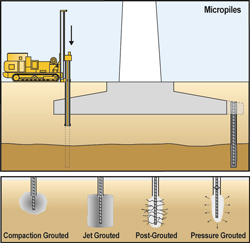Many deep foundation systems are available for support of wind turbine tower foundations, including driven piles, drilled caissons, augercast piles, and micropiles. Of these systems only micropiles are versatile enough to function either as a new foundation for a planned structure, or as a remedial solution for an existing foundation. Also known as minipiles, pin piles, needle piles or root piles, micropiles can provide exceptional value, particularly in difficult access situations—narrow access or low headroom—or in Karstic geology. Micropiles are available as a design-build service by specialty contractors. Micropiles are relatively small diameter piles (4 to 13 inches) that can be installed in almost any type of ground. Design loads as small as a couple of tons to in excess of 500 tons are achievable. They are generally constructed by drilling either a cased or an open hole in which reinforcing steel and high strength grout are placed.

Micropiles are often an ideal foundation element for wind turbine tower foundations because micropile tension (uplift) capacity is generally a high percentage of the compression capacity. They can be economical alternatives to caissons without compromising on performance. Micropiles are often located around the perimeter of the tower foundation to maximize the micropile capacity to resist the high overturning moments applied to wind turbine foundations. In addition to new tower construction, micropiles are often installed to remediate problems with existing tower foundations, or retrofit existing towers for changes in loading conditions. Micropiles can be installed through holes cored through an existing mat foundation. After installation the micropiles are bonded or mechanically attached to the mat. Alternately, micropiles can be installed around the perimeter of the mat, after which the connection is achieved by enlarging the mat. Although the highest capacity micropiles typically develop their capacity by bonding into bedrock, significant capacities are achievable by bonding into soils. Micropiles are often combined with a variety of grouting or ground treatment to maximize capacities.
These combinations include:
• Compaction grouted micropiles are able to develop loads at shallow depth in loose, sandy soils. Low mobility grout is pumped to expand the base geometry and densify the bearing soil layer.
• Jet grouted micropiles have a high load carrying capacity and are ideal for cohesive soils where the increase in bond surface area increases pile capacity.
• Post-grouted micropiles are suitable for all types of soils. Post grouting enhances the frictional capacity of the soil-pile interface and increases the surface area of the bond zone.
• Pressure-grouted micropiles have a high load carrying capacity in a wide range of soil types, from sands to clayey silt, to fractured rock.
The pile’s frictional bond capacity is enhanced by densification and grout permeation of the surrounding soil, or by consolidation of rock. Quality controls for micropiles can include monitoring grout volumes and pressures during construction of the piles to determine the condition of the subsurface profile as well as the final geometry of the pile. Grout samples taken from production piles during grouting are cast into cylindrical forms for the purpose of laboratory strength testing to verify that the minimum design unconfined compressive strength (UCS) is achieved. Full-scale compression load tests or tension load tests are typically performed on one or more production piles, or on one or more test piles near the proposed micropile locations. Since their initial development over 50 years ago, micropiles have been employed to support every type of structure. Because of their versatility in design and installation, micropiles are an efficient and economical solution for wind turbine foundations.

































